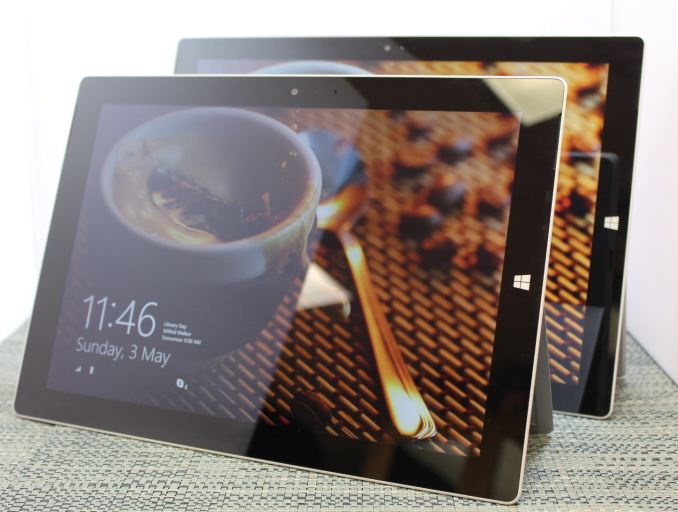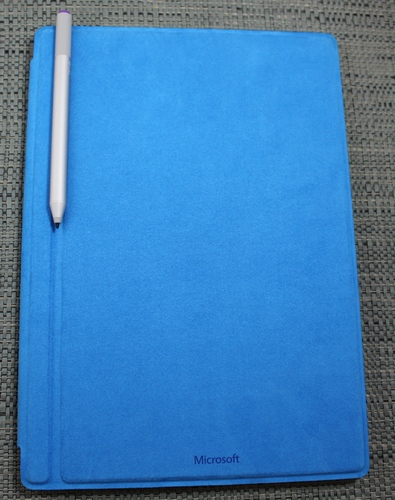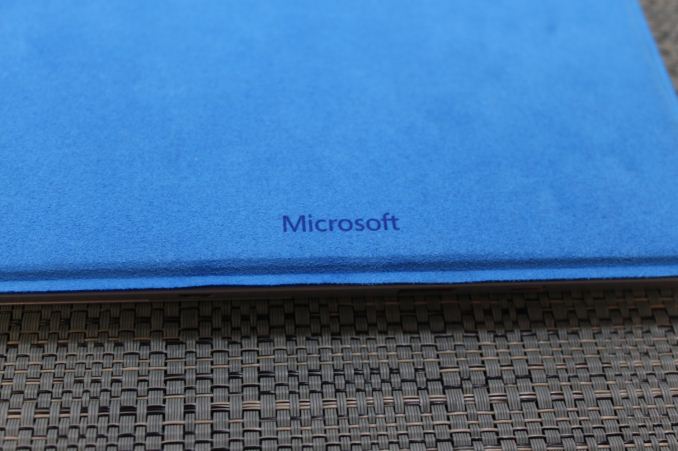The Surface 3 Review
by Brett Howse on May 4, 2015 9:00 AM ESTFinal Words
In the Windows space, there is quite a bit of variety in tablets. Some are well under $100, and some go over $1000. In this space, the Surface Pro 3 has done very well, establishing a name for itself with good performance in a small form factor. Microsoft is certainly trying to emulate this success with the Surface 3, and for good reason. With the Surface Pro 3, they got a lot right, so it makes sense to push the value line in the same direction.
The Surface 3 is superior to its predecessors in many ways. Where they were good, it is better. It keeps the wonderful magnesium chassis, but stretches it into a 3:2 aspect ratio. This alone is almost worth the price of admission, but it is just one of many changes made. I would argue that it is one of the most important changes to this tablet, and it makes it a better tablet and a better laptop. The kickstand has always been a staple of the Surface lineup, and adding the one additional step really helps make it even more usable in more scenarios. I wish it opened just a bit wider like the Pro model does, but that is a small gripe.
The move to x86 with the Atom x7-8700 was long needed. No longer is Surface and Surface Pro not able to run the same applications. Windows RT was always going to be a tough sell, but even more so since the Windows Store did not take off as quick as would have been necessary for RT to have a future. Once Intel shipped Bay Trail though, the writing was on the wall for Windows RT, since there was little reason to sacrifice the backwards compatibility of x86. The move to Cherry Trail in this model has provided a speed boost as well, and for light workloads it is more than sufficient. Plus, you could run anything that a Surface Pro could run, even if it will take a bit longer. That is an option that just did not exist before with the Surface line.
That being said, the SoC performance is where the price point dictates - around the good ARM products but poorer compared to Core. This is especially true when compared to the Surface Pro 3, but it is worth noting the SoC power draw between the two (14W vs 2W). That being said, the performance of the eMMC is a major drawback to how this device feels, especially in day to day use. Most of the time it isn't noticable, but when there is a bottleneck most of the time it was due to disk accesses.
From a long term usability standpoint, getting rid of the 32 GB model and having Surface 3 start with 64 GB is a big boost. 32 GB is a tough sell when you have the larger install footprint of Windows, as well as a recovery partition. Add in some Windows Updates, and a 32 GB model is going to be near capacity right away, and that really diminishes eMMC’s performance. Now the base model starts at 64 GB, and for just $100 more, you can opt for the 128 GB model which also has 4 GB of RAM. I personally think that would be $100 well spent, and if I was buying, that would be the model I would go for.
The accessories are also first rate. The keyboard is really quite good, and although the trackpad is small, it does work well when needed. It is a bit on the pricey side but it really does complete the Surface 3 and gives you the laptop capabilities in a nice cover. When I was using it as a tablet, I almost always removed the keyboard though, so it is certainly not a must have, but a really should have. Adding the pen to the lineup for this round was also a great move. Being able to use the Surface 3 for quick notes came in very handy, and I found the pen to be quite easy to glide over the screen, and accuracy was top notch. Of the accessories, the dock is likely not something the average consumer needs, but it really is a nice dock for storage and charging. At $199 though, it is too much for the average person to go for. For businesses though, it should come in very handy and should help the Surface 3 gain some traction there. It is not quite as good as the Surface Pro’s dock though, since this model lacks the proprietary docking port of the Surface Pro 3.
There is a lot to like about the Surface 3, but not everything is perfect. Battery life, especially when compared to other tablets, is well below average. This is despite having a display with a pixel density less than a lot of the competition, which means the Surface 3 should have an advantage in backlight power consumption. Display power draw is a huge concern, and perhaps the Panasonic one in the Surface 3 is not quite as efficient as others, especially Sharp’s IGZO lineup. The overall battery life is still decent though, and the much improved standby time is a big boon. However the charge rate is really a problem on this tablet, and it would have been excellent to see this new device embrace USB Type-C as the charging connector. Since it already has a full sized USB 3.0 port, there would be very little downside to moving to the new connector for charging, and it would allow for a reversible insertion as well.
I think though that the battery life is really the only real concern for the Surface 3. In the Windows space, there is no other tablet quite like this one, except maybe the Surface Pro 3, but that device is bigger, and heavier, and less useful as a tablet. It does have far more performance available, but for far more money up front.
Up to this point, I have not discussed the ability to use Surface 3 in your lap at all, and for good reason. For people out in the world that need to be able to use a device in their lap, then please just buy a notebook computer. Almost none of the 2-in-1 devices that I have tested have been especially good at that task, even those with true attachable keyboards. Only the devices like the Yoga 3 Pro which keep the processor in the base have the correct balance for this task. The Surface 3 can work in a pinch, but it is much better suited to be used on a desk with the keyboard attached if you need to use it as a notebook.
Pricing is the final piece of the puzzle. At $499, you get a decent spec with 2 GB of memory and 64 GB of storage. The $599 model bumps that to 4 GB of memory and 128 GB of storage. It is not inexpensive. Add in the keyboard for another $130 and the Surface 3 is getting close to the pricing of the ASUS UX305, which has a lot more performance available. The pen is another $50 on top. The base price of the Surface 3 is, I think, competitive, but adding in the accessories to really make it what it is advertised as ramps the price up in a hurry.
So with those caveats aside, we can finally get to the conclusion that you have likely guessed already. The Surface 3 is a great device. The build quality is really at the top level of any OEM out there. The form factor is finally the right one after two previous generations that got it slightly wrong. The weight is lighter than any previous Surface, and just as balanced. Performance of the x7 Atom CPU is great for light tasks, and if you need more than light tasks then this is not the device for you. As a tablet, it is great to use in either orientation, with the portrait mode being especially good now for browsing the web. The kickstand is improved, they keyboard is improved, the base tier steps up to 64 GB of storage, making it actually useful without immediately adding micro SD to the mix.
With Windows 10 right around the corner, the Surface 3 feels like Microsoft’s best attempt yet at creating a great tablet computer. If you in the market and you want a Windows 8.1 tablet, it would be worth your time to check out the Surface 3.













265 Comments
View All Comments
Alexvrb - Monday, May 4, 2015 - link
Actually in many regards the Surface 3 has the superior display. Sorry! Also in terms of SoC performance, the CPU side of the x7 is great and very competitive. If you're looking for 3D performance it's not as impressive but this would not be the best device for that workload - you'd be better off with a laptop/hybrid or a Surface Pro!Speedfriend - Tuesday, May 5, 2015 - link
"And people buy it because it doesn't run windows, too."Increasingly people don't buy the Ipad if the plummeting sales are any indication. My iPad stay on the sofa for basic web browsing, email and videos. Anything else I have to get my laptop for, becuase the iPad is basically pretty useless. And having recently bpought a cheap Android tablet to carry to work to watch movies on, I have realised that an iPad offers nothing that a cheap Android tablet can't do. I will never buy another iPad, it is just an overpriced toy. I wil buy a Surface though as it can actually replace my laptop for almost every task.
romprak - Tuesday, May 5, 2015 - link
The iPad is showing its lack of utility even in Apple's lineup, where large phones handily do most of the stuff an iPad used to be relied upon, and cheap tablets do web browsing as well as an iPad. Tablets are great for families, but why buy a $500 tablet for your child, when devices that can do almost as well are available for much, much less - and your children are unlikely to care too much whose logo is on the device?Apple is in trouble with the iPad, they need to either update the OS or come up with something killer for it.
In contrast, my family can use a Windows machine for all sorts of stuff - from programming (my 10 year old son is programming now), all the way to playing games on Steam. So, why iPad? Seems superfluous.
akdj - Tuesday, May 12, 2015 - link
I wouldn't call the 'slack' quarter sales of 17 million iPads 'trouble for Apple'. They sold more iPads then every Surface sold in aggregate, since its birth....last ¼ Alone! And that's six months post release.I like the SP3 Pro, I think MS nailed it. Surface 3 looks like a very nice step forward. That said, Apple HAS updated the OS and as an ambidextrous user or both Windows and OS X, I've found the continuity/handoff features built into iOS 8/OS X 10.10 to easily be the biggest advancement in some time --- especially between devices; phone, tablet and desktop or notebook.
Funny thing, I've got a ten year old as well. Also coding right now --- and I'm learning with him. He's building a cross platform app for his science fair.
He's coding on iOS only. Although he's got access to the iMac and MacBook Air, he's much happier learning both Objective C/Swift on iOS, using the free university lectures, notes and information along with a couple very excellent 'touch' coding 'apps'
It's funny to listen to rehashed arguments about the iPad and how it's for the couch potato only. I've flown 22 hours since Saturday morning, around Alaska with tourists looking to fish, shoot stills or motion, capture audio or wrap production in other areas of the state. My iPad is my kneeboard; plans my flights and files my plans, distributes weight and balance of the A/C, shows me real time weather, traffic, and up to date Jep charts and plates. It's been invaluable as a 'display' for small field edits, using as a remote viewfinder to capture sketchy wildlife and there's never a concern with battery life.
I do enjoy reading on the iPad, creating, invoicing clients or paying my utilities. I can take calls, use MS Office (whoever said it's a stripped version obviously hasn't used iOS Office, it's amazing!) Dropbox or iCloud, Box or Google Drive (I've found many Google apps to be better on iOS than my Android devices, currently using a Note 4), as well a plethora of powerful apps like iMovie, GarageBand, Pages Numbers and Keynote...all optional, none are bloated. iOS takes up a ½ dozen GBs, not two dozen! And if the RT3 suffers this much graphically, there's a LIMIT on 'all those X86' programs that actually WILL run on the rig
Sure, you'll be able to run CS3 efficiently and it sounds like games from a decade ago might work, but Iike the iPad, you're not gonna be manipulating 50megapixel Raw images nor creating killed effects in AE or transcoding video any faster. There's a trade off either way and IMHO, it's cool to see this significant a jump in performance on the new RT
I was also impressed with the SP3. That said, the iPad Air 2 is one helluva tablet at one pound and using TCAS and ADS-B with three dimensional moving maps with weather and traffic, GPS and nav aids that were easily 50-60 pounds for each pilot to carry around or avionics to add... Now in less than a one pound package, it's definitely NOT in trouble.
I think it's such an excellent device --- my original as well as iPad 2 are working great and the kids love them...most folks aren't updating them like phones. They're still selling nearly a 100,000,000 a year! That's hardly trouble. Even if the slip YoY spooks you, just remember how many are already out there, that the mini is only two and half --- 1 ½ with retina, and the Air 2 was the tick. Not that tock...yet they've managed to sell more in their worst quarter than every other tablet manufacturer combined! (Not to mention their mind blowing 6 & 6s sales, I'm sure their just fine canabalizing their own iPad sales with 6 and 6+ sales which are also pocket computers).
Times have changed and 'most' folks have everything they need in today's tablets. Today's smartphones. Regardless of which OEM they've decided on. Once they're happy, it's kind of a pain to 'change over' and these are extremely personal devices when compared to the home computer
Sorry about the length. But I enjoy and love using both OS X and (one of about six or seven dolts that enjoy using) Win 8.1. I've also used Android since 08 (still have my Xoom!) and iOS since '07. I currently use a Note 4 and 6+. Biz. Personal. As much as I enjoy Windows, OS X is certainly the 'go to OS' in our house.
Not to mention, OS X comes complete with training wheels for someone like romprak. It's called Bootcamp and you're welcome to install any OS you'd like. Unlike Windows.
bobjones32 - Monday, May 4, 2015 - link
For your claim of better performance, how well does the iPad run Win32 apps?mkozakewich - Tuesday, May 5, 2015 - link
That's not performance, that's functionality. If the exact same chip magically supported dual-booting x86 Win10, I'm sure it would do slightly better. That's not the power of Atom, though. It wasn't designed to blow everything else out of the water. (I'm sure it'll get better power characteristics on heavy load tests, for instance, because of its conservative power use.)What it all boils down to: This is a great device. It's different than an iPad, though, and different people will need different things from it. I feel a premium tablet can live at $500-$600, but a slightly-compromised tablet that runs Windows and is only truly complete with a $120 accessory will need to sweeten the deal to have obvious value to the common consumer.
It's a close game, but Surface needs a nudge. I suppose it'll get that in a couple months when it goes on sale for a bit.
MrTetts - Tuesday, May 5, 2015 - link
I never understand people who say this device is overpriced.. I just don't. For what it does, I would say it is very well priced.Stevegt87 - Thursday, May 7, 2015 - link
While the surface 3 is more capable than an ipad. A new ipad runs 100% of ipad software perfectly. Surface 3 is low on cpu/gpu/ram/disk for much of the desktop experience that it enables.Stevegt87 - Thursday, May 7, 2015 - link
Game are made to run perfectly on an ipad. Games will humble surface3augiem - Monday, May 4, 2015 - link
This thing is already $100 cheaper than a 128GB Air 2, does WAY more, has more memory, etc. How cheap is cheap enough? Would you really want them to sacrifice something like build quality, screen quality, or other necessities to reach a price point lower than this? They do have to stay in business after all. Running full Windows in the tablet space is completely unheard of and adds far more than $50 worth of value to this product compared to its competition.